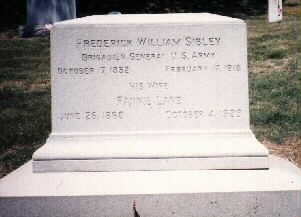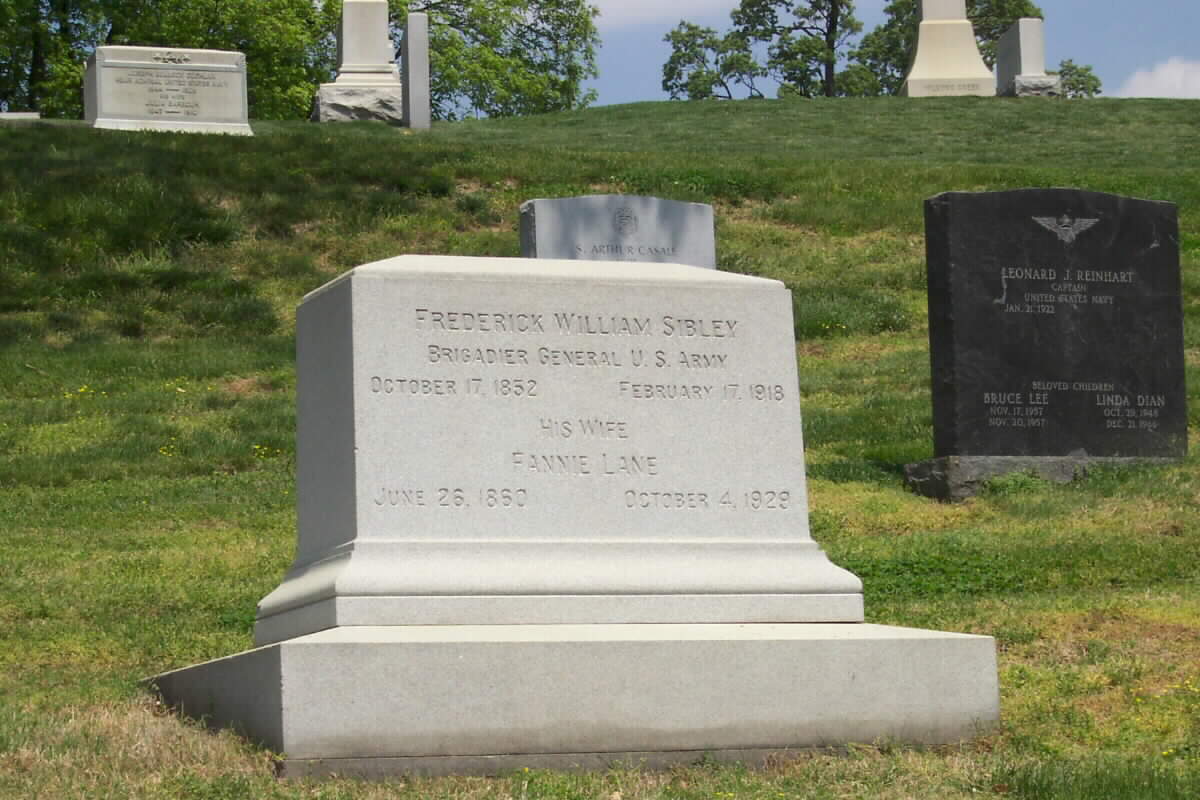Born at Phantom Hill, Texas, October 17, 1852, the son of General C. C. and Nancy Davenport Sibley, he graduated from West Point in 1874. He married Fannie, the daughter of Colonel E. D. Lane, USA, in 1877.
He was commissioned Second Lieutenant, 2nd U.S. Cavalry on June 17, 1874 and was promoted through the ranks to Colonel, 14th U.S. Cavalry, March 3, 1911. He served for ten years against Indians in the Rocky Mountains and on the Plains.
He participated in nearly all of General George Crook’s engagements with Sioux and Cheyenne Indians. He as breveted for “gallantry in action on the Little Big Horn River,” in June 1876 and was recommended for the Medal of Honor. He served as Adjustant, 2nd Cavalry, 1889-93 and 1899-1900; Inspector General, Department of Texas, 1900-01. During the Spanish-American War, he commanded the Headquarters Guard, IV Army Corps, under Major General John Coppinger. He was Adjutant General, Department of Luzon, Philippines, 1903-04, and was in command of squadrons of the 2nd Cavalry and battalions of the 7th U.S. Infantry, which suppressed Landrones of Cavite and Bantangas Provinces, 1905, returning invalided to the United States. He was selected for detail to the General Staff, but declined in December 1908.
He served as Commandant of Cadets at West Point, February 1, 1908-February 1, 1911.
He died on February 17, 1918.
SIBLEY, FANNIE W/O F W
- DATE OF DEATH: 02/18/1918
- DATE OF INTERMENT: 02/21/1918
- BURIED AT: SECTION E SITE 3651
ARLINGTON NATIONAL CEMETERY - WIFE OF FW SIBLEY – BRIG GEN US CAV
SIBLEY, FREDERICK W
BRIG/GEN USA
- VETERAN SERVICE DATES: Unknown
- DATE OF DEATH: 02/17/1918
- DATE OF INTERMENT: Unknown
- BURIED AT: SECTION W SID SITE 3651
ARLINGTON NATIONAL CEMETERY
From a contemporary news report:
“Rockford, Illinois, February 18, 1918: Frederick W. Sibely, for many years a leading Cavalry officer who took part in early Indian campaigns and later in the Spanish-American War is dead at the base hospital at Camp Grant. Death as due to pernicious anemia. Sibley, who was at one time Commandant at West Point, came to Camp Grant from the Mayo Hospital in Rochester, Minnesota, where he had undergone treatment. As Colonel of the 14th Cavalry, he took part in the pursuit of Pancho Villa into Mexico in 1916. In July of that year he was appointed Brigadier General and was retired the following year October for age.
“He was born in Texas October 17, 1852 son of the late Colonel Caleb C. Sibley, USA, and was appointed to West Point from Georgia in 1869. Five years later he graduated and was appointed a Second Lieutenant, assigned to the 2nd Cavalry,which was then on the Nebraska frontier. In 1876 he was a member of the Big Horn Expedition and fought the Indians on the Powder River at the battle of the Rosebud and Slim Buttes. General Crook detailed him to a scouting party which located a war party of Sioux in the vicinity of the Little Big Horn, and for gallant services on this occasion he was promoted to First Lieutenant. He went to Cuba as a Captain in 1899 and in 1902 became Major of the 11th Cavalry. In the Fall of the following year, he went to the Philippines with the 2nd Cavalry and commanded several expeditions against Landrones of Cavite and Batagnas Provinces, exterminating the bands. In 1909 he was appointed Commandant at West Point.”
He is buried in Section 2 of Arlington National Cemetery. His wife, Fannie Lane Sibley(June 26, 1866-September 4, 1923), is buried with him.
FREDERICK WILLIAM SIBLEY
Birth Date: 17 October 1852
Birth Place: FORT PHANTOM HILL, TEXAS
Death Date: 17 February 1918
Death Place: ROCKFORD, ILLINOIS
Occupation: United States Army.
He graduated number 23 in the Class of 1874 at the United States Military Academy, and was assigned to the Second Cavalry in the Wyoming Territory. For the next ten years he served with distinction in the Indian Campaigns in Wyoming, Montana, and the Dakotas. He participated in all of General Crook’s engagements against the Sioux and Cheyenne and was brevetted for gallantry in action on the Little Big Horn River in July 1876. He was brevetted for distinguished gallantry in action against Crazy Horse’s camp on Powder River, Montana, 17 March 1876, and he was recommended for the Medal of Honor. At this time he was a Second Lieutenant. On one occasion he commanded a scouting party which met a large war party which they could not hope to beat. They took shelter in some nearby woods, leaving their horses tied in full view of the Indians. They retreated further into the woods and for two days they traveled over the worst terrain imaginable on foot without food or sufficient clothing to protect them during the cold n nights. The party finally reached General Crook’s camp though they were so exhausted that they could only march for ten minutes at a time. Some of the healthiest men in the party were delirious. Despite these difficulties Lieutenant Sibley did not lose a single man. General Crook’s statement concerning the service of Sibley contained this comment: “The coolness and judgment displayed by Lieutenant Sibley and Frank Gruard, the guide, in the conduct of this reconnaissance, made in the face of the whole force of the enemy, are deserving of my warmest acknowledgments. Lieutenant Sibley, although one of the youngest officers in this department, has shown a gallantry that is an honor to himself and the Service.”
During the War with Spain Captain Sibley, Second Cavalry, served with troops attached to the headquarters, Fourth Army Corps, as headquarters guard, Major General John Coppinger, Commanding.
In 1903 and 1904 Major Sibley, Second Cavalry, served in the Philippines as Adjutant General, Department of Luzon. He was engaged in combat against the ladrones of Cavite in 1905, which group he subdued completely.
Lieutenant Colonel Sibley filled the very important post of Commandant of Cadets at the United States Military Academy from 1 February 1909 to 20 January 1911. He was promoted to Colonel 3 March 1911 and assigned to the Fourteenth Cavalry. He served again in the Philippines until March 1912. His last tour of duty was with the Big Bend Cavalry Patrol and the Mexican Punitive Expedition. His career included 41 years with troops and was crowned with promotion to Brigadier General 27 July 1916. He retired 17 October 1916.
Spouse: FANNIE ELIZA LANE
Birth Date: 26 Jan 1860
Birth Place: SAN ANTONIO, TEXAS
Death Date: 4 October1929
Death Place: STERNBERG ARMY HOSPITAL, Philippine Islands
Marriage Date: 1 Sep 1877
Marriage Place: FORT SANDERS, WYOMING
Children:
MARY LUCILE
GERTRUDE
MARY LUCILE SIBLEY
Birth Date: 7 Aug 187
Birth Place: FORT KEOGH, MONTANA
Death Date: 11 March 1928
Death Place: WASHINGTON, D.C.
Spouse: JOHN BUFFALO CHRISTIAN
Birth Date: 30 August 1870
Birth Place: CALET, MISSOURI
Death Date: 21 April 1938
Death Place: SAN ANTONIO, TEXAS
Occupation: U.S. ARMY
Education: GRADUATE, U.S. MILITARY ACADEMY, 1896.
Marriage Date: 1 Dec 1898
Marriage Place: FORT SHERIDAN, ILLINOIS
Michael Robert Patterson was born in Arlington and is the son of a former officer of the US Army. So it was no wonder that sooner or later his interests drew him to American history and especially to American military history. Many of his articles can be found on renowned portals like the New York Times, Washingtonpost or Wikipedia.
Reviewed by: Michael Howard


